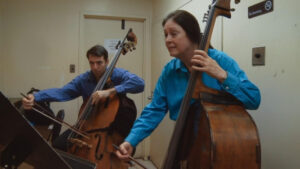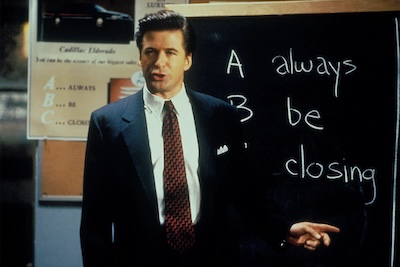You think a lot about your own family while you watch Netflix’s The Only Girl in the Orchestra, Molly O’Brien’s ode to her aunt, Orin O’Brien. Sure, not all of us grew up idolizing the first female member of the New York Philharmonic, but O’Brien’s documentary short extends beyond the milestones and the historical context to reveal the humanity of a performer who loves her craft and longs to be a part of something bigger than herself. Some of us make the best music when we have others to play music with, after all. While Orin O’Brien might be the first woman to join the ranks of the Philharmonic, Molly O’Brien’s film will surely give way to legions of newer, but equally adoring, fans.
Would you be able to construct a film about someone you love and remain objective? It’s harder than one might think. What I love about O’Brien’s film is that we see her aunt through her own eyes, and it helps that Molly makes a few appearances alongside Orin. There is distance but also closeness, and she explains that the process was much more collaborative than the normal profile.
“It’s not an easy thing to do,” O’Brien confirms. “As a documentarian with a journalism background, there’s a real firewall between the participants and the reporter of the filmmaker. When you’re dealing with something like this, though, it’s less like journalism and more like memoir writing or like writing a personal essay. For me, the only way I could do it was view it as a collaboration with Orin as an exchange with her. Everything we did was run by her [first], and we did show her specific scenes whenever she was playing or with students. She knows what sounds better than we do. I would approach any film with a family member in that way. The priority should be preserving the relationship and staying away from making it an interrogation.”
It’s not often that you see a film whose subject resists the spotlight. Orin insists to her niece that she prefers playing as part of a group and even expresses her embarrassment when the press insisted on highlighting her entry into the Philharmonic because of her gender.
“One of the central themes of the film is put down the violin and pick up the double bass,” she says with a laugh. “Let’s stop being soloists, and we can work together as an ensemble–that can apply to many arenas that aren’t involved with the performing arts. It certainly can in many arenas that we’ve been facing in the last couple of weeks. We need to be an ensemble, and that wasn’t surprising coming from Orin because I’d heard it in conversation with her for years and years. I think that it’s a long life, and sometimes we change from being a soloist to being part of a group. In an ideal world, everyone would have their chance and be able to be center stage, if they wanted to take it. The rest of us should be right with that. We would stop elbowing each other out of the way to get there. What Orin proves when she compares her life to the life of her parents, my grandparents who were movie stars, is that by taking that attitude and enjoying what you’re creating with other people, you can find a more pleasurable place to be.”

One of the most constant presences in Orin’s life is, obviously, the double bass, and Only Girl introduces us to several of her leading men. They have heft on screen whether they are standing at attention in Orin’s apartment or lounging on top of bed looking as if they are ready to take a nap. Just by looking at them, you can see how this director wanted to highlight the varying relationships to each instrument.
“When I was eleven years old, I visited Orin in New York City, and when I walked into her apartment, there were these six double basses in that rack that you see in the film,” she says. “They just looked like these gorgeous, broad-shouldered, handsome, European men. There’s an Italian, there’s an English guy, there’s the French bass. I fell in love with them–they’re so beautiful. There’s one French one that has Mother of Pearl inlaid on the edges. Since they are such beautiful objects, I was very interested in photographing them, and I worked with my cinematographer, Martina Radwan, on the challenge since it’s a very vertical instrument. It would’ve been easier if I made this film for TikTok. We had to loosen the camera from the tripod as much as we could and do handheld work with it when there was performance work. Then we used locked-off shots of them at rest in the bed, in the corner, and under the piano. They are everywhere, and they have their separate, distinct personalities. Orin has different relationships with all of them.”
Orin’s face lights up in a different way when she is teaching. There’s something about watching an artist view and consume the medium that they excel in while extending that generosity to others. It’s a different facet to Orin’s abilities as a musician, and Molly insists that it’s the foundation of her aunt’s legacy. We can learn a lot about those we love when we see them absorbing the things that they love.
“She has influenced me in so many ways, and you when I have that emotional moment at her kitchen table about how I want to navigate my life the way that she has,” O’Brien says. “In some ways, I have. I started teaching documentary production and theory at Chapman University in Los Angeles when I lived there for a few semesters. I would drive the freeway home back to Silver Lake from Orange County, and I’d have all the windows down and the music blasting–my hair blowing in the wind. I was so energized by the young people around me who love documentary and wanted to know everything that they could. My dad was a professor and my mom was a psychologist and a professor, so there’s a legacy of teaching in my family.
I think in Orin’s case, and I don’t think she would mind me saying, that she is one of the best double bass players in the world, but her legacy is really about teaching and bringing forward the school called the Czech School of Double Bass Playing in central Europe. Robert Zimmerman, who taught Orin, was also in the Philharmonic, so there’s this legacy, this passing on of the knowledge that’s super close to her and her heart.”
The Only Girl in the Orchestra is available on Netflix.






![‘Pirates! The Penzance Musical’ Breakout Star Nicholas Barasch Discusses Performing On The Tonys With Seven Stitches On His Face [VIDEO]](https://thecontending.com/wp-content/uploads/2025/06/Pirates0011r-120x86.jpg)


